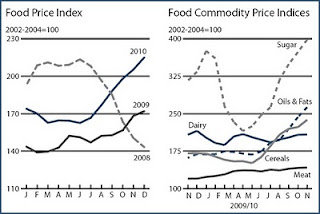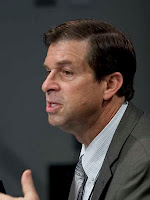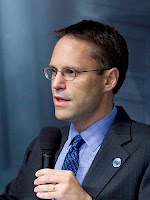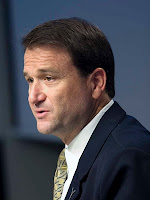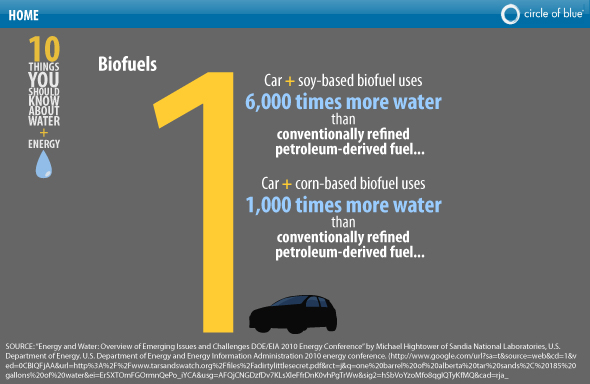-
Mapping the Hot Spots of the 2010/11 Food Crisis
›If you’ve taken a trip to the supermarket lately or scanned the headlines you may have noticed something: Food prices are on the rise. Worldwide, food prices are on track to reach their highest point since their peak in 2008. Using data from the Food and Agriculture Organization (FAO), the International Food Policy Research Institute (IFPRI), and the World Bank, the Environmental Working Group (EWG) and ActionAid have collaborated to create an interactive world map called, “Hot Spots in the Emerging Global Food Crisis.”
The focus of the map is to highlight the 52 most at-risk countries where increases in staple food prices could tip the scales of stability. There are three variants of the map to choose from: countries at risk which depend on imported cereals, countries where prices are already increasing (featured above), and countries with vulnerable economies and high rates of hunger.
Food prices have become a hot topic of conversation lately for their alleged role in the instability that is rocking the Middle East/North Africa region. But the Middle East is not the only area affected: Besides in Algeria, Tunisia, Morocco, Jordan, and Egypt, food-related riots and protests have also broken out in Mozambique, Bolivia, and India. As the map’s accompanying text puts it, these food riots “feed deeper discontent about economic inequalities and hunger and help give rise to revolutions that can topple governments, as in Tunisia and Egypt.”
Scrolling over a country reveals more information, like, for example, the specific percentage increases in the price of wheat or rice over the past year (wheat prices have risen 15.9 percent in China vs. 54 percent in Kyrgyzstan) or the amounts of corn, soybean, and wheat annually imported and exported (Afghanistan exported 908 million metric tons of wheat in 2010 while Egypt imported 4,978).
Users can also click on vulnerable countries to see how many people are malnourished and their per capita income per day. In the Democratic Republic of the Congo, for example, an estimated 42 million people were undernourished between 2005 and 2007, and the average person lives on $0.28 per day. According to EWG and ActionAid, the total number of people living in extreme poverty rose by 25 million in 2008 during the last global food crisis. Since June 2010, the start of the current upward trend in prices, the World Bank estimates that 44 million people have fallen into extreme poverty.
One recommendation from EWG and ActionAid for developed countries and the United States in particular: Stop looking to biofuels as an energy option. In their view, “spending scarce taxpayer dollars to shift crops from food to biofuels at the expense of hungry people and already stressed resources like soil, water, and air is unsustainable.”
Image Credit: Map courtesy of the Environmental Working Group and ActionAid, and Food Price Index and Food Commodity Indices, extracted from Global Food Price Monitor, January 2011, courtesy of the Food and Agriculture Organization.
Sources: ActionAid International, BBC News, CNN, the Environmental Working Group, The European Union Times, Time, Voice of America, World Bank. -
Choke Point U.S.: Understanding the Tightening Conflict Between Energy and Water in the Era of Climate Change
›Without sharp changes in investment and direction, the United States’ current strategy to produce sufficient energy — including energy generated from clean sources — will lead to severe water shortages, and cause potentially major damage to the country’s environment and quality of life. These are the conclusions from a comprehensive reporting project, “Choke Point U.S.” presented by Circle of Blue at the Woodrow Wilson International Center for Scholars on Sept. 22, 2010.
At the event hosted by the China Environment Forum and Environmental Change and Security Program, J. Carl Ganter, Director of Circle of Blue, Keith Schneider, Circle of Blue’s senior editor, and Jeffrey J. Fulgham, Chief Sustainability Officer and Ecomagination leader at General Electric, discussed the findings of “Choke Point: U.S.,” an analysis of the tightening linkage between the nation’s rising energy demand and finite domestic freshwater supplies. The four-month Circle of Blue project explored whether the nation’s transition to a clean-energy economy will have net dividends or deficits for U.S. freshwater resources in an era of climate change, rising population, and a projected 40-percent rise in energy demand by 2050.
“In the next decade, every single sector will need to reform due to water shortage. This is not in fifty years, this is in the next decade,” Schneider told an audience of more than 70 energy and environmental experts from the research, policy, business, and security sectors.
As part of the project, Ganter said that Circle of Blue dispatched reporters to the coal fields of southern Virginia, the high plains of the Dakotas, California’s Central Valley, Midwestern farms, and other regions throughout North America. On one hand, their reporting revealed riveting narratives about the urgent contests between energy development and water supply, and how those contests can be resolved. On the other hand, the reports also recognized the extraordinarily difficult challenges that the energy-water nexus will pose to regional economies, governing practices, technological development, and the quality of natural resources.
Schneider, who directed the reporting, summarized the findings:- Unless the U.S. government plans more carefully, generating energy from clean alternatives is almost certain to consume much more water than the fossil fuels that green energy sources are meant to replace.
- The region confronting the energy-water choke point in the most dramatic fashion is the Southwest, where climate change is steadily diminishing snowmelt in the Rocky Mountains, and a prolonged drought is threatening to halt energy production at the Hoover Dam.
- The next era of hydrocarbon development is well underway in the United States, as energy companies invest billions of dollars a year to tap the “unconventional” oil sands of Canada, the oil shales of the northern Great Plains, and the gas shales of the Northeast, Texas, Oklahoma, and the Upper Midwest. However, tapping each of these carbon-rich reserves is using three to four times more water than the conventional oil and gas reserves they are replacing.
- Developers in North Dakota are spending roughly $7 billion annually to drill 1,000 wells a year now into the Bakken Shale. That effort will produce 100 million barrels of oil and 100 billion cubic feet of gas this year, but will use billions of gallons of North Dakota’s scarce groundwater.
- Each of the thousands of wells drilled each year into the unconventional gas shales underlying the Northeast, Gulf Coast states, the West, and Midwest requires three million to six million gallons of water injected under high pressure to fracture the rock and enable gas to flow out of the rock.
- In Kern County, California, where the agriculture and oil industries compete for diminished supplies of water for irrigation and energy production, the winner is the oil industry.
- The energy vector in the United States points strongly to more fossil fuel consumption, not less.
- All new energy technologies except wind and solar PV will require increased freshwater withdrawals.
From General Electric’s perspective, the next five to ten years will produce significant leaps in water technology that, if combined with efficient water use, appropriate valuation of water, and more holistic policies, will be key in avoiding an impending water Choke Point.
The speakers said that the trends identified in “Choke Point U.S.” could have serious implications not just for the United States, but also for freshwater supplies around the world. In August, Circle of Blue joined with the Wilson Center’s China Environment Forum to develop “Choke Point: China,” — a companion to the “Choke Point: U.S.” study — which will produce front-line research, reporting, and analysis about one of China’s most important resource competitions.
Peter Marsters is a Program Assistant with the China Environment Forum at the Woodrow Wilson Center.
Photo Credit: “Hoover Dam overlook,” courtesy of flickr user Creativity+ Timothy K Hamilton. -
Circle of Blue Launches ‘Choke Point: U.S.’ Series Examining Intersection of Water and Energy Resources
›Speaking yesterday at the Wilson Center, Circle of Blue Senior Editor and New York Times reporter Keith Schneider called his organization’s latest project, reporting on the intersection of finite water resources and growing demand for energy around the world, one of the most important stories of his career. First in the series is Choke Point: U.S.:
For as long as the United States has been a nation the central idea guiding energy development is to generate as much as the energy sector is capable of producing. In every way imaginable, though, the 21st century is testing the soundness of that principle. A number of environmental, economic, and political impediments lie in the path to large increases in American energy production.
For more check out Circle of Blue’s full feature as well their multimedia section, with infographics illustrating water regulations and power generation type by state, North Dakota’s remarkable rise to “domestic oil royalty,” and video interviews with residents and experts from around the country (including the Wilson Center’s Jennifer Turner, on China).
None, though, is more significant than the nation’s steadily diminishing reserve of fresh water. The place where rising energy demand collides with declining water supplies is a national choke point that the United States has barely begun to address, and certainly isn’t close to resolving.
Beyond the United States, Circle of Blue and the Wilson Center’s China Environment Forum also hope to start-up a “Choke Point: China” but are still seeking funding.
Image Credit: Graphic courtesy of Ball State University graduate student, Mark Townsend, and data compiled by Circle of Blue’s Aubrey Ann Parker and Andrea Hart. -
“All Consuming:” U of M’s ‘Momentum’ on Population, Health, Environment, and More
›August 23, 2010 // By Schuyler NullMinnesota’s Institute on the Environment is only in its third year of operation but has already established itself as an emerging forum for population, health, and, environment issues, due in no small part to its excellent thrice-a-year publication, Momentum. The journal is not only chock-full of high production values and impressively nuanced stories on today’s global problems, but is also, amazingly, available for free.
Momentum has so far covered issues ranging from food security, gender equity, demographic change, geoengineering, climate change, life without oil, and sustainable development.
Highlights from the latest issue include: “Girl Empower,” by Emily Sohn; “Bomb Squad,” with Paul Ehrlich, Bjørn Lomborg, and Hans Rosling; and “Population Hero,” on the fiscal realities of stabilizing growth rates.
The lead story featured below, “All Consuming,” by David Biello, focuses on the debate over whether consumption or population growth poses a bigger threat to global sustainability.Two German Shepherds kept as pets in Europe or the U.S. use more resources in a year than the average person living in Bangladesh. The world’s richest 500 million people produce half of global carbon dioxide emissions, while the poorest 3 billion emit just 7 percent. Industrial tree-cutting is now responsible for the majority of the 13 million hectares of forest lost to fire or the blade each year — surpassing the smaller-scale footprints of subsistence farmers who leave behind long, narrow swaths of cleared land, so-called “fish bones.”
Continue reading on Momentum.
In fact, urban population growth and agricultural exports drive deforestation more than overall population growth, according to new research from geographer Ruth DeFries of Columbia University and her colleagues. In other words, the increasing urbanization of the developing world — as well as an ongoing increase in consumption in the developed world for products that have an impact on forests, whether furniture, shoe leather, or chicken fed on soy meal — is driving deforestation, rather than containing it as populations leave rural areas to concentrate in booming megalopolises.
So are the world’s environmental ills really a result of the burgeoning number of humans on the planet — growing by more than 150 people a minute and predicted by the United Nations to reach at least 9 billion people by 2050? Or are they more due to the fact that, while human population doubled in the past 50 years, we increased our use of resources fourfold?
Photo Credit: “All Consuming” courtesy of Momentum. -
Backdraft: The Conflict Potential of Climate Mitigation and Adaptation
›The European Union’s biofuel goal for 2020 “is a good example of setting a target…without really thinking through [the] secondary, third, or fourth order consequences,” said Alexander Carius, co-founder and managing director of Adelphi Research and Adelphi Consult. While the 2007-2008 global food crisis demonstrated that the growth of crops for fuels has “tremendous effects” in the developing world, analysis of these threats are underdeveloped and are not incorporated into climate change policies, he said. [Video Below]
-
Deepwater Horizon Prompts DOD Relief Efforts, Questions About Energy Security
›May 6, 2010 // By Schuyler NullAs the crippled Deepwater Horizon oil rig continues to spew an estimated 210,000 gallons of crude oil a day into the Gulf of Mexico, the Department of Defense has been asked to bring its considerable resources to bear on what has become an increasingly more common mission – disaster relief.
British Petroleum has requested specialized military imaging software and remote operating systems that are unavailable on the commercial market in order to help track and contain the spill.
In addition, the Coast Guard has been coordinating efforts to burn off oil collecting on the ocean’s surface and thousands of National Guard units have been ordered to the Gulf coast to help erect barriers in a bid to halt what President Obama called “a massive and potentially unprecedented environmental disaster,” as the oil slick creeps towards the coast.
As shown by these calls and the ongoing earthquake relief effort in Haiti, the military’s ability to respond to large-scale, catastrophic natural (and manmade) disasters is currently considered unmatched. The first Air National Guard aircraft was on the ground in Haiti 23 hours after the earthquake first struck, and DOD’s Transportation Command was able to begin supporting USAID relief efforts almost immediately. The Department of Defense also spearheaded American relief efforts after the 2004 tsunami and played a critical role in providing aid and security in New Orleans after Hurricane Katrina.
The Pentagon’s four-year strategic doctrine, the Quadrennial Defense Review (QDR), released earlier this year, predicts that such humanitarian missions will become a more common occurrence for America’s military, as the world grapples with the destabilizing effects of climate change, population growth, and competition over finite energy resources. Some experts see this expansion of the military’s portfolio as an essential part of a “hearts and minds” strategy, while others are critical of the military’s ability to navigate the difficulties of long-term reconstruction.
The QDR also highlights DOD’s efforts to reduce the need for oil – and thus deepwater oil rigs – in the first place.
The DOD as a whole is the largest consumer of energy in the United States, consuming a million gallons of petroleum every three days. In accordance with the QDR, Pentagon leaders have set an ambitious goal of procuring at least 25 percent of the military’s non-tactical energy requirement from renewable sources by 2025. The Air Force – by far the Pentagon’s largest consumer of petroleum – would like to acquire half of its domestic jet fuel requirement from alternative fuels by 2016 and successfully flight-tested a F/A-18 “Green Hornet” on Earth Day, using a blend of camelina oil and jet fuel.
At a speech at Andrews Air Force Base in March, President Obama lauded these efforts as key steps to moving beyond a petroleum-dependant economy. However, at the same event, he announced the expansion of off-shore drilling, in what some saw as a political bone thrown to conservatives. Since the Deepwater Horizon incident, the administration announced a temporary moratorium until the causes of the rig explosion and wellhead collapse have been investigated.
Cleo Paskal, associate fellow for the Energy, Environment, and Development Programme at Chatham House, warns that without paying adequate attention to the potential effects of a changing environment on energy infrastructure projects of the future – like the kind of off-shore drilling proposed for the Gulf and Eastern seaboard – such disasters may occur more frequently.
In an interview with ECSP last fall, Paskal pointed out that off-shore oil and gas platforms in the Gulf of Mexico were a prime example of how a changing environment – such as increased storm frequency and strength – can impact existing infrastructure. “Katrina and Rita destroyed over 400 platforms, as well as refining capacity onshore. That creates a global spike in energy prices apart from having to rebuild the infrastructure.”
The Department of Defense has demonstrated – in policy, with the QDR, and in action – that it can marshal its considerable resources in the service of renewable energy and disaster relief. But given the scope of today’s climate and energy challenges, it will take much more to solve these problems.
Photo Credit: “Deepwater Horizon,” courtesy of flickr user U.S. Coast Guard. U.S. Air Force Tech. Sgt. Joe Torba of the 910th Aircraft Maintenance Squadron, which specializes in aerial spray, prepares to dispatch aircraft to a Gulf staging area. -
DOD Measures Up On Climate Change, Energy
›May 5, 2010 // By Schuyler Null“As Congress deliberates its role, DOD is moving ahead steadily on a broad range of energy and climate initiatives,” says former Senator John Warner in a recent Pew report, Reenergizing America’s Defense: How the Armed Forces Are Stepping Forward to Combat Climate Change and Improve the U.S. Energy Posture.
The military as a leader and catalyst for renewable energy was a key focus of the recently released Quadrennial Defense Review (QDR), which for the first time included consideration of the effects of climate change and excessive energy consumption on military planning:Assessments conducted by the intelligence community indicate that climate change could have significant geopolitical impacts around the world, contributing to poverty, environmental degradation, and the further weakening of fragile governments. Climate change will contribute to food and water scarcity, will increase the spread of disease and may spur or exacerbate mass migration.
According to the Pew report, the Department of Defense has set a goal of producing or procuring at least 25 percent of its non-tactical electric energy needs from renewable sources by 2025. Highlights of the service’s efforts include:
The Pew report offers a generally favorable appraisal of the military’s response to the “twin threats of energy dependence and climate change” and the progress made towards reaching federal energy mandates. However, the authors let slide that the overwhelming amount of DOD energy usage is tied to tactical consumption, which has been given inadequate attention thus far (consider that the senior Pentagon official overseeing tactical energy planning was only just appointed, although the position has existed since October 2008).- The U.S. Navy’s “Great Green Fleet” carrier strike group, which will run entirely on alternative fuels and nuclear power by 2016;
- The construction of a 500-megawatt solar facility in Fort Irwin, California by the U.S. Army which will help the base reach ‘net-zero plus’ status;
- The goal of acquiring 50 percent of the U.S. Air Force’s aviation fuels from biofuel blends by 2016;
- The U.S. Marine Corps’ 10×10 campaign to develop a comprehensive energy strategy and meet ten goals aimed at reducing energy and water intensity and increasing the use of renewable electric energy by the end of 2010.
Interest in this field has grown quickly, as evidenced by the more than 400 people gathered at the launch of the latest report from the Center for New American Security (CNAS), Broadening Horizons: Climate Change and the U.S. Armed Forces – a big increase from the 50 or so at CNAS’ first natural security event in June 2008.
The CNAS study, much like the Pew report, breaks down the military’s efforts by service, but the study’s authors – including U.S. Navy Commander Herbert E. Carmen – thankfully provide more specific recommendations for what could be done better.
Based on research, interviews, and site visits, the study offers geographically specific recommendations for each of the Unified Commands, as well as seven broad recommendations for DOD as a whole:
“While we believe there is still much work ahead, there is a growing commitment to addressing energy and climate change within the DOD,” said USN Commander Carmen in the report:- In light of its implications for the global commons, ensure that DOD is included in the emerging debate over geoengineering.
- Urge U.S. ratification of the UN Convention on the Law of the Sea in order to provide global leadership and protect U.S. and DOD interests, especially in the context of an opening Arctic sea.
- Eliminate the divided command over the Arctic and assign U.S. Northern Command (NORTHCOM) as the supported commander.
- The U.S. government should make an informed decision about constructing nuclear reactors on military bases and provide clear policy guidelines to DOD.
- Congress and DOD should move away from the “cost avoidance” structure of current renewable energy, conservation, and efficiency practices in order to reward proactive commanders and encourage further investment.
- All of the services should improve their understanding of how climate change will effect their missions and capabilities; e.g. migration and water issues may impact Army missions, a melting Arctic, the Navy.
- The Air Force should fully integrate planning for both energy security and climate change into a single effort.
Indeed, in our conversation with officials in the Office of the Secretary of Defense for Policy, it was clear that, in developing the climate change and energy section of the 2010 QDR, the Department of Defense has developed a nascent, intellectual infrastructure of civilian and military professionals who will continue to study the national security implications of climate change, and, we hope, will continue to reevaluate climate change risks and opportunities as the science continues to evolve.
A holistic view of national security that includes energy and environment, as well as demographic and development inputs, continues to gain traction as an important driver in DOD policy and planning.
Photo Credit: “Refueling at FOB Wright” courtesy of Flickr user The U.S. Army. -
Weekly Reading
›The American Security Project (ASP) launched its Climate Security Index, which identifies climate change “a clear and present danger to the national security of the United States,” at an event hosted by George Washington University. ASP warns that “American leaders will face a multitude of tough choices as climate-induced national security threats begin to compete with and crowd out our ability to respond to traditional threats,” reports ClimateWire.
According to “Fewer Emitters, Lower Emissions, Less Cost,” contraception is almost five times cheaper than conventional green technologies as a means of combating climate change. “[E]ach $7 spent on basic family planning (2009 US$) would reduce CO2 emissions by more than one ton,” researchers conclude, while low-carbon technologies would add an extra $25 per ton.
Experts at a recent forum on sexual and reproductive health and development in Berlin also argued for making the population-climate link, although it did not appear in the Call to Action. Helen Clark, administrator of the UN Development Programme (UNDP), said that there is a “virtuous cycle formed by educating women and families in the developing world on the number of children they actually wish to have, improving the health of women and promoting gender equality, reducing poverty and hunger, and mitigating climate change.”
The World Bank has suspended International Finance Corporation (IFC) funding of operations in the palm oil sector over concerns that lending could be causing social and environmental harm, says Mongabay.com. World Bank President Robert Zoellick announced the move in a letter to NGO leaders who argued that IFC-backed palm oil production in Indonesia was fuelling deforestation, land grabbing, and human rights abuses.
In “Urban Poverty and Vulnerability in Kenya,” Oxfam warns that Kenya “is facing a new urban timebomb, with millions of Nairobi residents suffering a daily struggle for food and water as the divide between rich and poor widens.” The group points out that “the price of staple foods such as maize has more than doubled in the past year” and drought has led to an outbreak of cholera “as almost 90% of slum dwellers have no piped clean water.”
“Water and Conflict: Incorporating Peacebuilding into Water Development” from Catholic Relief Services outlines a way for development and human rights practitioners to integrate water and peacebuilding in their projects, drawing on the experiences of CRS and other development organizations, mainly in Central and South America.
Showing posts from category biofuels.


